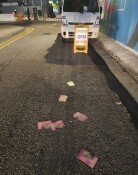Statistics Provoking Hostility towards the Rich
Statistics Provoking Hostility towards the Rich
Posted October. 04, 2006 07:08,
The Ministry of Government Administration and Home Affairs (MOGAAHA) announced it has reorganized last years land-ownership statistics table, which gave rise to the bungling statistics controversy, into 10 categories including individual, household, region, and others, and insisted, For building the groundwork of real estate estimation, statistics of both individuals and households are required.
How Many Children Own Real Estate?-
Im a mother of two children who are studying in elementary and middle school respectively. How many families are there in which property is even available for their children? Indeed, isnt it only possible for the children of a chaebol family? an Internet user named jato asked us.
She said it is incredible that the top one percent of the population, which includes infants and children, possess 57 percent of private-owned land, which MOGAAHA argues in the statistics of land ownership analysis. Statistical distortions can be easily found even in data provided by MOAAHA.
According to data from MOGAAHA, those in their 50s and 60s comprise the highest proportion (51.8 percent) in land-ownership ratio, followed by the 40s (19.5 percent) and the 70s (14.2 percent). Those under the age of 20 years comprise only 0.3 percent. By including people under 20, who do not own land in reality, into a population causes enormous disparities in land ownerships.
Among Koreas population of 47,280,000, the number of those under 20 is estimated to 12,087,000 according to the 2005 population census.
Kim Gyeong-hwan, a professor of economics at Sogang University, said, The land ownership survey including young people who cannot afford to buy land lacks meaning as a statistic.
An MOAAHA official said, Some misunderstanding can occur with regards to the census of individual landowners. However, in terms of households, the top one percent of landowners representing nearly 100,000 units possesses 30.3 percent of the total land, and it is measured that 59.3 percent of the total land is owned by the top five percent of 500,000 households. Therefore, the statistics does not distort the real situation seriously.
Real Estate Polarization Controversy-
Some say it is hard to see the real estate polarization as the government announced, since most of the land the wealthy land owners have are not much relevant to real life, such as hills or fields.
Professor Kim explained, "In the 1999 World Bank report on the comparison of inequality for agricultural land ownership, South Korea ranked first in terms of equality of agricultural land ownership among the 60 countries including the U.S. and Japan."
He analyzed, "The 2004 social statistics research shows the possession rate of owning ones own home, such as a residence or apartment, is 62.9 percent, the same level as that of developed countries. This means that that many people own their own land. Therefore it is hard to say that the wealth is skewed."
Meanwhile, MOAAHA opened only individual sources when it released the statistics of land ownership analysis. Responding to our indication about statistical problems, it released statistics based on households, but it was too late. This year, it produced the statistics both in terms of individuals and households. However, the lingering criticism about impartiality of statistics per capita seems to continue.
beetlez@donga.com




![반찬통 착색 고민 끝…‘두부용기’ 버리지 말고 이렇게 쓰세요 [알쓸톡]](https://dimg.donga.com/c/138/175/90/1/wps/NEWS/IMAGE/2026/01/09/133126593.3.png)


